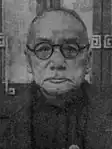1947 Chinese National Assembly election
The 1947 Chinese National Assembly election was held between 21 and 23 November 1947 in China. This is the first election of under the newly ratified 1947 Constitution of the Republic of China. Under this constitution, the National Assembly is an authoritative legislature body that holds the power as constitutional convention and presidential electoral college. A total of 2,961 delegates were elected from across the country.[1]
| |||||||||||||||||||||
3,045 seats to the National Assembly | |||||||||||||||||||||
|---|---|---|---|---|---|---|---|---|---|---|---|---|---|---|---|---|---|---|---|---|---|
| Registered | ~250,000,000 | ||||||||||||||||||||
| Turnout | ~4-8% | ||||||||||||||||||||
| |||||||||||||||||||||
Background
Following the establishment of Republic of China, indirect elections were held in 1912 and 1918 for the National Assembly, 1931 for the Nationals Assembly (Chinese: 國民會議) and 1936 for Constitutional Assembly (Chinese: 制憲大會).
In December 1946, the Constitutional Assembly adopted the new Constitution, effective from 25 December 1947. Delegates for National Assembly shall be elected before the constitution came into effect, which would be similar to Electoral College in the United States. In April 1947, China Democratic Socialist Party and Chinese Youth Party entered the re-organised Nationalist government. The two minority parties demanded to field 238 and 288 candidates in the election, despite significantly higher than their representations in the Constitutional Assembly. They also proposed the proportional representation in the election and was rejected.[2] John Leighton Stuart, Ambassador of the United States to China, criticised the minority of their greed for power.[3] He later recommended postponing the election as it could endanger peace negotiation of civil war, but Chiang insisted the election as the key step for constitutional governance.[4]
| Title | Role | Constitutional provisions | Amended provisions | First election |
|---|---|---|---|---|
| National Assembly delegate | Exercise political powers on behalf of citizens | Directly elected by citizens of county-level divisions | Institution de facto suspended, with its powers transferred to the Legislative Yuan and referendums | 1947 Chinese National Assembly election |
| President | Head of state | Indirectly elected by the National Assembly | Directly elected by the citizens within the Free area | 1948 Chinese presidential election |
| Legislative Yuan members | Legislature | Directly elected by citizens of provincial-level divisions | Directly elected by the citizens within the Free area | 1948 Chinese legislative election |
| Control Yuan members | Monitoring authority | Indirectly elected by provincial legislatures | Parliamentary chamber de facto suspended. Appointed by the President and confirmed by the Legislative Yuan | 1947–1948 Chinese control election |
Overview, criticism, reactions
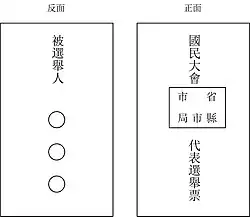
The election was held between 21 and 23 November 1947 across China. Single non-transferable vote was used as the electoral system. With an empty ballot, voters were required to write down the name of the candidates voting for. Along with underdeveloped voter identification system, large number of invalid ballots were found and fraud was widely reported.[6][7][8]
The election received mixed reaction within China,[9] with some praising the expansion of voting rights to women and farmers while denouncing the election as lacking other essential elements of democracy,[10] but still general appreciation internationally.[11] Ambassador Stuart commented that, despite the unsatisfactory conditions of the election, the election marked the start of democracy in China.[12]
Results
Turnout

According to Central News Agency, the official broadcaster, and Ta Kung Pao, there were around 250 million of eligible voters, compared to a total population of 461 million.[13] Official newspaper Central Daily News, however, gave the number of voters at 350 million.[10] The Government reported the turnout at 20 million,[14] despite neutral observers doubted whether the total reached 10 million.[15] With the government reported figures, the turnout was at 8%.

Elections could not be organised or could partly conducted in provinces or cities occupied or controlled by the Communist troops or Soviet forces, such as Dairen, Tsitsihar, Harbin, Lyushun, affecting around 800 to 900 constituencies as per government report.[16] Turnout in cities was higher than rural area, with more than half of voters casting ballots in Canton.[17] Overseas voting were met with legal obstacles relating to nationality, especially in the United Kingdom and the colonies, but the electoral procedures in the United States were carried out quite successful as dual citizenships were permitted.[18]
Seats breakdown
In principle, the electoral districts were designed to elect one delegate for each county or equivalent of China. China recognized the result of the 1945 Mongolian independence referendum, hence this election was only held in the Mongolian leagues and banners within provinces of China, or roughly the territory of modern Inner Mongolia. The Tibetan electoral districts includes the Tibet Area as well as the Tibetan regions within provinces of China. Most of Tibet were controlled by the semi-independent Kashag government at this time.
| Electoral district type | Seats | Delegates | ||
|---|---|---|---|---|
| elected | not elected | |||
| Counties, cities, and equivalents | 2,177 | 2,141 | 36 | |
| Inner Mongolia | 57 | 57 | 0 | |
| Tibet | 40 | 39 | 1 | |
| Minority ethnic groups in frontier area | 34 | 34 | 0 | |
| Overseas Chinese | 65 | 22 | 43 | |
| Occupational groups | Regional | 216 | 216 | 0 |
| Nationwide | 271 | 268 | 3 | |
| Women groups | Regional | 148 | 147 | 1 |
| Nationwide | 20 | 20 | 0 | |
| Nationals in China proper with special convention | 17 | 17 | 0 | |
| Total | 3,045 | 2,961 | 84 | |
Party breakdown
The opposition parties urged Kuomintang to ensure the quota of elected delegates be reached prior to the election,[19] reportedly at 230 and 202 for the Youth and Democratic Socialist respectively.[10] Kuomintang is suggested to have won "in landslide", taking at least 80% of legislative seats,[10] equivalent to more than 2,000 seats in National Assembly. Many Kuomintang-nominated candidates, however, still lost in the election, while party members nominated by voters won. Kuomintang later passed a controversial and unconstitutional resolution, forcing those elected delegates with KMT affiliation to give up their seats such as to fulfill the demand from the opposition, as they threatened to withdraw from the National Assembly in protest.[20] The chaos following the resolution forced the meeting to postpone from 25 December 1947 to 29 March 1948, and only ended as it was declared seats would not needed to be given up.
Due to the lack of data over the political affiliation of elected delegates, the numbers below were estimations from the given details.
| Political party | Standing | Elected | |
|---|---|---|---|
| Kuomintang | 1,758 | More than 2,000 | |
| Chinese Youth Party | 288 | 76 | |
| China Democratic Socialist Party | 238 | 68 | |
| Independents | ? | ? | |
| Total | ? | 2,961 | |
Results in Taiwan
The islands of Taiwan and Penghu were under Japanese rule before 15 August 1945. Before World War II, few Taiwanese people were selected by the Government of Japan to participate the Imperial Diet. As a result of World War II, the Republic of China Armed Forces occupied Taiwan on behalf of the Allies. The government established Taiwan Province to mark its annexation of Taiwan.
The administrative divisions of Taiwan consist of 8 counties and 9 cities. However, an additional delegate seat were added to Taichung County and Tainan County respectively due to their population. There were 19 delegates elected in this election.
| Party | Votes | % | Seats |
|---|---|---|---|
| Valid votes | 1,925,739 | 98.29 | 19 |
| Invalid/blank votes | 33,415 | 1.70 | – |
| Total | 1,959,154 | 100 | 19 |
| Source: Nohlen et al. | |||
Aftermath

The election was organized by the Kuomintang-led Nationalist government. Elected National Assembly delegates started its first session on 29 March 1948 in Nanking. The exact number of delegates attending the meeting remained unknown due to numerous circumstances, such as deaths before or after election, declined to inaugurate, resigned after the first meeting, or disqualified for law offenses. Records showed 2,859, among 2,961 elected, reported the attendance in the opening of the National Assembly first meeting. The number of attendees increased to 2,878 when the meeting reached the end on 1 May 1948.
The inauguration of the first National Assembly marks the transition of China into constitutional governance. Chiang Kai-shek, the leader of the Nationalist government, was elected by the National Assembly delegates in the later presidential election to be the first President of the Republic of China in the constitutional government.
However, the Kuomintang-led Government of the Republic of China lost the Chinese Civil War in the next year of 1949. This resulted the government to retreat to Taiwan. Around half of the National Assembly delegates came to Taiwan with the government. Since the government had lost control over mainland China. The delegates extended their own terms until "re-election is possible in their original electoral district." This situation remained until a Constitutional Court (Judicial Yuan) decision in June 1991 that orders the terms to terminate by the end of 1991.
The National Assembly delegates elected actually served in office from 29 March 1948 to 31 December 1991, which equals 43 years and 278 days.
Related elections
Previous and next legislative elections
There were some regime changes happened in China during the first half of the 20th century. Depends on the definition, possible previous and next elections for legislatures with similar functions are listed below.
| Order | Election | Political entity | Note |
|---|---|---|---|
| Previous | 1918 Chinese National Assembly election | Elected the 2nd National Assembly under the Beiyang government | |
| Next | 1st National People's Congress | Elected the 1st National People's Congress | |
| 1969 Taiwanese legislative election | Elected supplementary delegates served together with the 1st National Assembly | ||
| 1991 Taiwanese National Assembly election | Elected new delegates to form the 2nd National Assembly |
Presidential elections in National Assembly
The government of the Republic of China claims the sovereignty over the whole China. However, due to the inability to hold re-elections in mainland China after 1949, the National Assembly delegates elected in 1947 still held elections in Taiwan to elect the President and Vice President every 6 years in accordance with the constitution. This situation remained until the democratization took place in Taiwan in the 1990s under the Lee Teng-hui administration.
| Order | Presidential Election | Voting delegates | President | Vice President |
|---|---|---|---|---|
| 1st | 1948 Chinese presidential election | 1947 | Chiang Kai-shek | Li Tsung-jen |
| 2nd | 1954 Taiwanese presidential election | 1947 | Chiang Kai-shek | Chen Cheng |
| 3rd | 1960 Taiwanese presidential election | 1947 | Chiang Kai-shek | Chen Cheng |
| 4th | 1966 Taiwanese presidential election | 1947 | Chiang Kai-shek | Yen Chia-kan |
| 5th | 1972 Taiwanese presidential election | 1947, 1969 | Chiang Kai-shek | Yen Chia-kan |
| 6th | 1978 Taiwanese presidential election | 1947, 1969, 1972 | Chiang Ching-kuo | Hsieh Tung-min |
| 7th | 1984 Taiwanese presidential election | 1947, 1969, 1980 | Chiang Ching-kuo | Lee Teng-hui |
| 8th | 1990 Taiwanese presidential election | 1947, 1969, 1986 | Lee Teng-hui | Lee Yuan-tsu |
Gallery
 Officials were explaining the voting regulations
Officials were explaining the voting regulations A worker was casting his ballot
A worker was casting his ballot Professors from Chiao Tung University were casting ballots
Professors from Chiao Tung University were casting ballots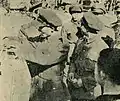 Armed forces in Nanking were voting
Armed forces in Nanking were voting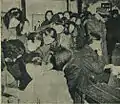 Voters voting in the first direct election
Voters voting in the first direct election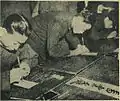 Voters voting in the first direct election
Voters voting in the first direct election Chiang Kai-shek voted for Chen Yu-kuang, head of University of Nanking
Chiang Kai-shek voted for Chen Yu-kuang, head of University of Nanking Party flag of Kuomintang adjacent to the portrait of founding President Sun Yat-sen was replaced by Flag of the Republic of China, marking to end of one-party rule
Party flag of Kuomintang adjacent to the portrait of founding President Sun Yat-sen was replaced by Flag of the Republic of China, marking to end of one-party rule.jpg.webp) Females in rural areas were granted voting rights
Females in rural areas were granted voting rights.jpg.webp) Voter registration
Voter registration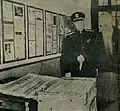 Yu Yu-jen, Director of the Control Yuan, was voting
Yu Yu-jen, Director of the Control Yuan, was voting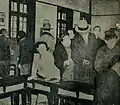 Wu Tiecheng, Secretary-general of Kuomintang, was queueing to vote, along with other Nanking voters
Wu Tiecheng, Secretary-general of Kuomintang, was queueing to vote, along with other Nanking voters
See also
References
- Dieter Nohlen, Florian Grotz & Christof Hartmann (2001) Elections in Asia: A data handbook, Volume II, p548 ISBN 0-19-924959-8
- 各省市参议会反对大选采取比例制有关文电,中国现代政治史资料汇编,第四辑第八册
- 司徒雷登致国务卿马歇尔,1947-09-29,司徒雷登驻华报告,132页
- 司徒雷登驻华报告,136页
- 国民大会实录,国民大会秘书处,1948
- 行政院新闻局揭露关于协助南京办理国大代表普选投票中种种弊端的签呈,中国现代政治史资料汇编,第四辑第八册
- 大公报,上海,1947-11-24
- 佳木,民社党当前的心情,新闻天地,上海,第三十四期,1948-02-16
- "国大选举完毕" (in Traditional Chinese). 上海大公报. 25 November 1947.
{{cite journal}}: Cite journal requires|journal=(help) - Cheng, P. Y. (2001). "The Call of the Parliament of 1947–1948: Election under the Control of the KMT" (PDF). 中央研究院近代史研究所集刊. 35: 145–195.
- "The First Election for Assembly Representative in China". 纽约时报. 23 November 1947.
- 中央日报,1947-11-24 第二版
- "近代中国宪政民主的轨迹". 29 October 2020. Archived from the original on 29 October 2020. Retrieved 23 November 2021.
- "Nanking Puts Chinese Vote At 20 Million". Washington Post. 24 November 1947. p. 4.
- "20 MILLION CHINESE VOTE AT ELECTIONS Twenty". The Canberra Times. Canberra. 25 November 1947. Archived from the original on 27 October 2020. Retrieved 24 October 2020.
20 million Chinese men and women voted in China's first election, says the Associated Press correspondent. This represents one-tenth of those eligible to vote, but neutral observers doubt whether the total reached 10,000,000.
- By HENRY R. LIEBERMANSpecial to THE NEW YORK TIMES.. New York Times (1857-Current file). Nov 21, 1947. p. 22 (1 page)
- 民国广东大事记,羊城晚报出版社,页862 ISBN 7-80651-206-3
- 1948-01-21,王世-{杰}-日记,中央研究院,1990
- 国民党中央临常会讨论与民青两党互争国大代表名额问题的报告纪要,中国现代政治史资料汇编,第四辑第八册
- 中国现代政治史资料汇编,第四辑第八册


